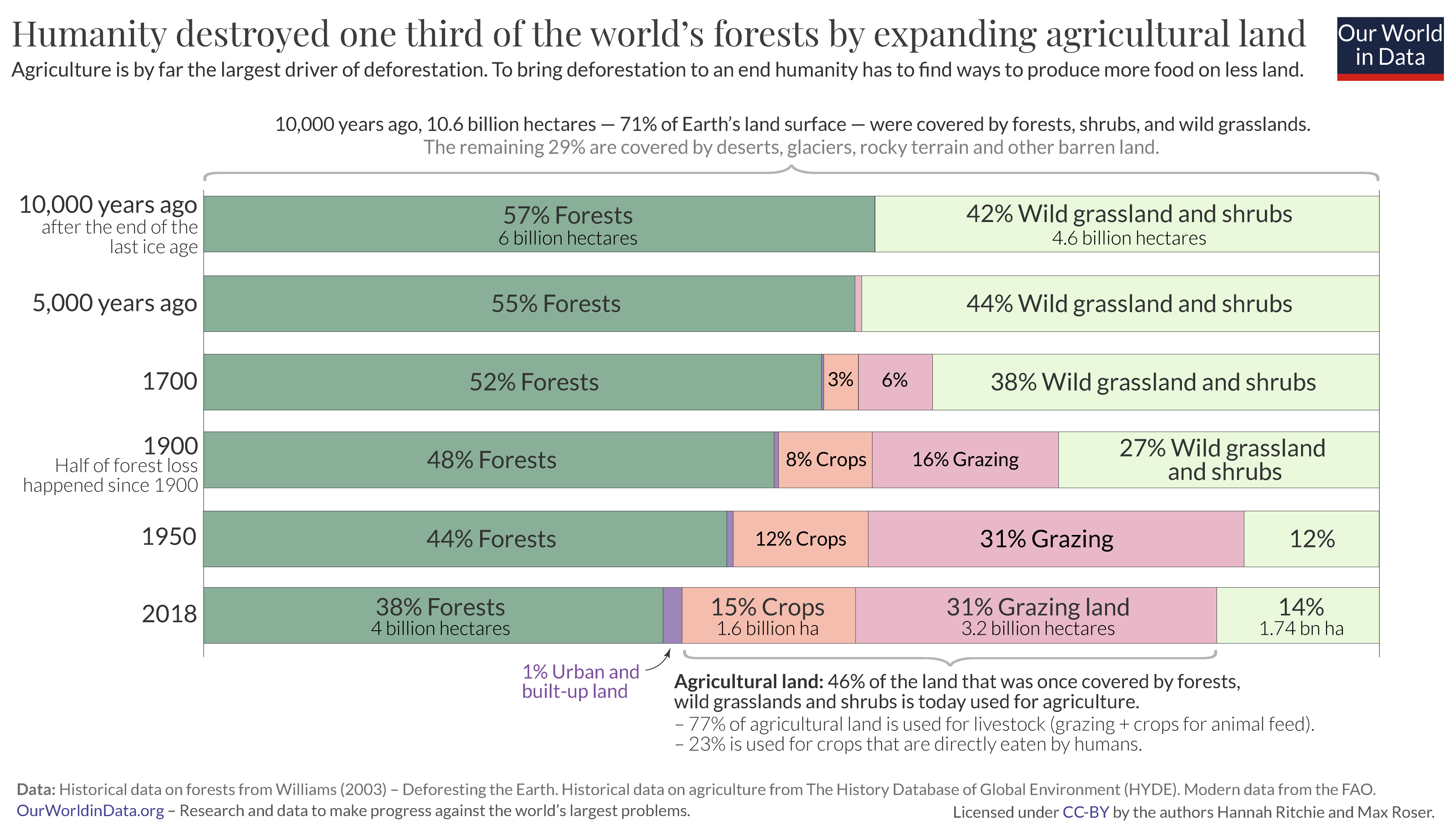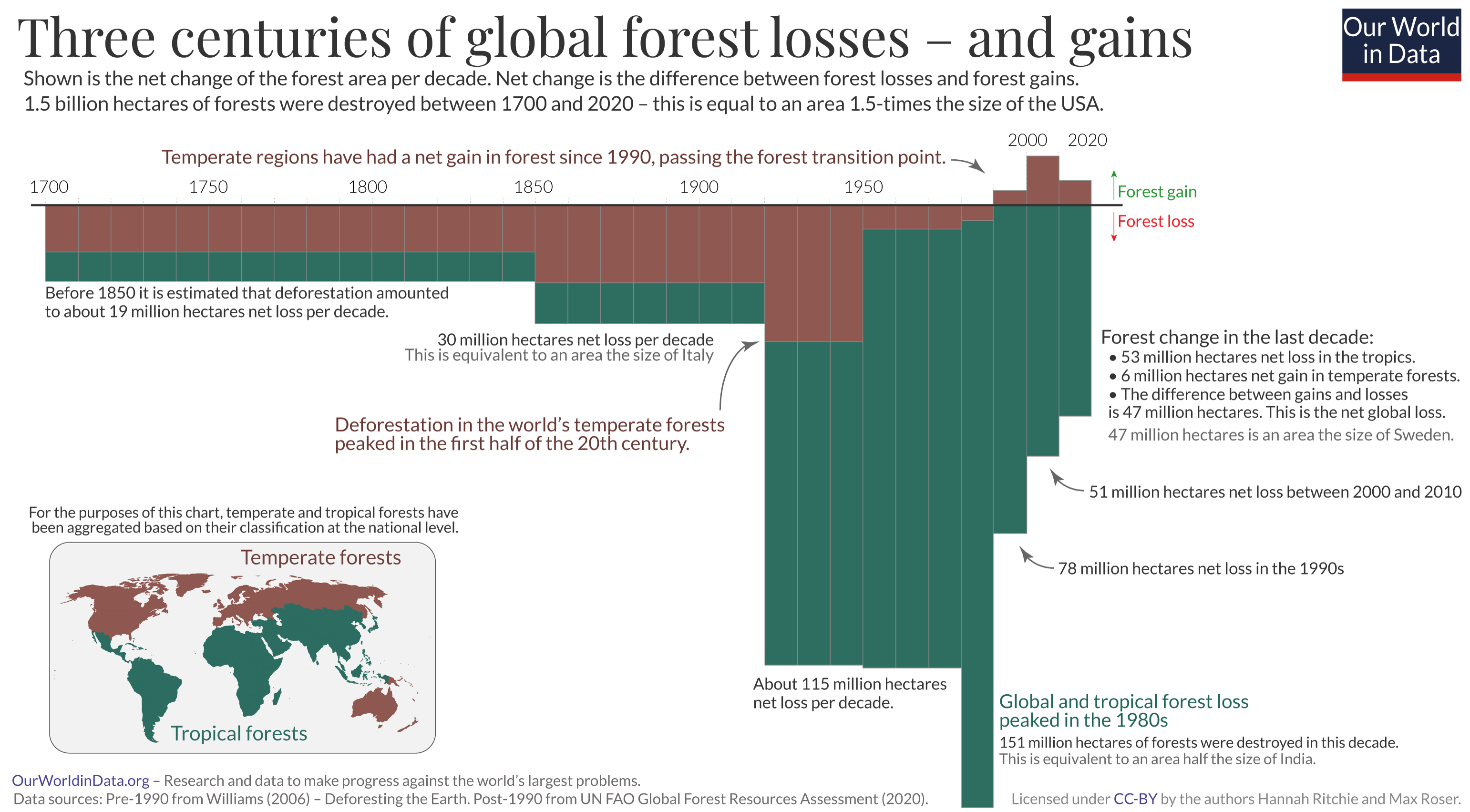For thousands of years humans have destroyed forests. At the end of the last great ice age, an estimated 57% of the world’s habitable land was forested.1 Since then, people in all regions of the world have burned and cut down forests. The chart shows this. The forested land area declined from 6 to 4 billion hectares. That means our ancestors destroyed one-third of the former forests – a forest area twice the size of the US was lost.
There are two big reasons why humans have destroyed forests and continue to do so – the need for land and the need for wood:
- We need wood for many purposes: as construction material for houses or ships, to turn it into paper, and – most importantly – as a source of energy. Burning wood is a major source of energy where there are trees but no modern energy sources available. Still today about half of extracted wood globally is used to produce energy, mostly for cooking and heating in poor households that lack alternatives.2
- By far, the most important driver of the destruction of forests is agriculture. Humanity cuts down forests primarily to make space for fields to grow crops and pastures to raise livestock. We also cut down forests to make space for settlements or mining, but these are small in comparison to farming.
The land use for farming did not only come at the expense of the world’s forests, but also led to the huge decline of the world’s other wild spaces, the shrub- and grasslands. The chart shows this too.

In many countries forests continue to be destroyed. The series of charts shows this. In all of these countries the forest cover today is lower than three decades ago.3

Most of the forests that are destroyed today are in the tropics, some of the most biodiverse regions on our planet. Why is this happening?
The following chart shows what is driving the ongoing destruction of the world’s largest tropical forest: the Amazon. The expansion of agricultural land to raise cattle is the most important driver, by far.4
I wish this was more widely understood. Land use for agriculture is the main threat to the world’s biodiversity.5

Most of the destruction of tropical forests is due to consumers in the region, but about 12% of the deforestation in the tropics is driven by demand from high-income countries. Beef-eaters around the world are contributing to the destruction of the Amazon rainforest.6
This huge impact of meat consumption on deforestation is also visible in the first chart that showed the history over the last 10 millennia – 31% of the world’s habitable land is now grazing land for livestock. This is an extremely large part of the world; taken together it is as large as all of the Americas, from Alaska in the North down to Tierra del Fuego in the South.
Meat consumption is such a large driver of deforestation because it is a very inefficient way to produce food. The land use of meat production is much higher than plant-based foods. Reducing meat consumption is therefore a way to increase the agricultural output per land area. A shift away from the land-intensive production of meat, especially beef, would be a major way to make progress and end deforestation. One possible way to get there is to make clear how large the environmental impact of meat production is. Another – complementing – way is to produce meat substitutes that people prefer over beef.
The end of deforestation?
After thousands of years of deforestation is there any hope that it could be different?
Yes.
In fact there are many countries that brought their history of deforestation to an end. Several even turned it around so that forests there are now expanding.
This reversal, from deforestation to reforestation, is called a Forest Transition. The chart shows the data for some of the countries that have achieved this.7
As mentioned before, while it is the case that several countries have achieved this transition, it is also the case that consumers in these countries contribute to deforestation elsewhere.

Crucial for these turnarounds was technological progress that reduced the demand for fuelwood and agricultural land.
- The demand for wood as a source of energy decreased when modern energy sources became available – initially fossil fuels, and more recently renewables and nuclear power.
- The need for more and more agricultural land decreased when existing farmland was used more efficiently – when an increase in food production was achieved by a higher output per area of land.
The increased productivity of the land thanks to modern agriculture allowed more and more countries to spare the forests that would otherwise be converted into agricultural land. Innovative modern crops, fertilizers, pesticides and irrigation make this increase of crop yields possible.
These two technological changes can be complemented by effective policies and regulations. Zero-deforestation policies restrict deforestation and programs like REDD+ of the FAO compensate poorer countries and farmers to make forest protection economically more attractive than deforestation.8
If we want to protect our planet’s forests the world as a whole would need to achieve what many countries have achieved already, the turnaround from deforestation to reforestation – a global forest transition.
Countries around the world have made the end of deforestation their explicit goal: At COP26 in Glasgow, countries with about 85% of the world’s forests pledged to end deforestation by 2030.
The last chart shows where the world is in this effort.
The brown part of the chart shows the history of the temperate forests. These forests as a whole have achieved the transition: deforestation was high in the past, then peaked in the first half of the 20th century, and from the 1990s onwards temperate forests have expanded in size. Temperate forests are growing back.
The challenge is now to achieve the same in tropical forests, which are shown in green. We are making progress in this direction: the rate of deforestation in the tropics was highest in the 1980s. Since then, the rate of deforestation has declined by a factor of three.
If we can further decrease the demand for fuelwood and agricultural land it seems possible to bring deforestation in the tropics to an end.
If we achieve the global forest transition in our lifetimes it would be a major success for the protection of the world’s biodiversity. Additionally it would bring greenhouse gas emissions from deforestation to an end, and expanding, rather than shrinking, forests would instead suck more carbon out of the atmosphere.

How can we bring deforestation to an end? There is no single answer, but, as we have seen, a few big changes can bring this big goal into reach.
More productive agriculture that allows more production on a smaller land area, a shift away from meat, effective conservation policies, and a shift to modern energy sources: by bringing all of these factors together we could get there. Not only would we save existing forests from being cut down, we might also free up space for forests to grow back.
In our lifetime we have the unprecedented opportunity to bring our long history of deforestation to an end. For the first time in millennia we could achieve a world in which forests expand.
Continue reading on Our World in Data:
Humanity’s relation to other mammals on our planet is in many ways similar to the history told here. Wild mammal populations have declined over the last thousands of years, but we can turn things around and achieve a future in which they flourish.
Acknowledgements: I would like to thank my colleague Hannah Ritchie for her helpful comments on this essay.


